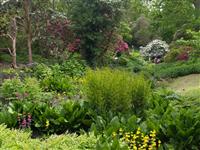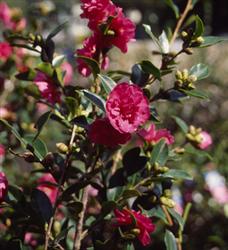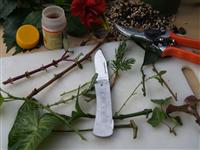
A Great Foundation Course in Horticulture
People with sound horticultural skills and knowledge are in demand in the industry - according to industry leaders, this is often lacking.
Gain those sought after skills by studying with ACS - an internationally respected college.
Students gain free membership to the AIH (Australian
Institute of Horticulture) or the CIH (Chartered Institute of
Horticulture (In the UK, Ireland and overseas).
There are two parts to this certificate:
A. COMPULSORY (CORE) UNITS
Students must complete and pass all of these core units.
1. Introduction to plants Minimum 40 hours instruction
The purpose of this study area is to explain the binomial system of plant classification and demonstrate identification of plant species through the ability of using botanical descriptions for leaf shapes and flowers.
 Objectives
Objectives
- Describe the relevant identifying physical features of flowering ornamental plants.
- Demonstrate how to use prescribed reference books and other resources to gain relevant information.
- Dissect, draw and label two different flowers.
- Collect and identify the shapes of different leaves.
- Demonstrate how to identify between family, genus, species, variety and cultivar.
2. Plant culture Minimum 60 hours instruction
The purpose of this study area is to demonstrate the ability to care for plants so as to maintain optimum growth and health while considering pruning, planting, and irrigation.
Objectives
- Describe how to prune different plants.
- Demonstrate how to cut wood correctly, on the correct angle and section of the stem.
- Describe how to plant a plant.
- Demonstrate an awareness of different irrigation equipment, sprinklers, pumps and turf systems available by listing their comparative advantages and disadvantages.
- Demonstrate competence in selecting an appropriate irrigation system for a garden, explaining why that system would be preferred.
- Define water pressure and flow rate and how to calculate each.
- Explain the need for regular maintenance of garden tools and equipment.
- List factors that should be considered when comparing types of machinery for use in garden maintenance.
 3. Soils and plant nutrition Minimum 50 hours instruction
3. Soils and plant nutrition Minimum 50 hours instruction
The purpose of this study area is to provide students with the skills and knowledge to identify, work with, and improve the soil condition and potting mixes, and to evaluate fertilisers for use in landscape jobs to maximize plant growth.
Objectives
- Describe the soil types commonly found in plant culture in terms of texture, structure and water-holding and nutrient holding capacity.
- Describe methods of improving soil structure, infiltration rate, water holding capacity, drainage and aeration.
- List the elements essential for plant growth.
- Diagnose the major nutrient deficiencies that occur in ornamental plants and prescribe treatment practices.
- Describe soil pH and its importance in plant nutrition.
- Describe the process by which salting occurs and how to minimise its effect.
- Conduct simple inexpensive tests on three different potting mixes and report accordingly.
- Describe suitable soil mixes for container growing of five different types of plants.
- List a range of both natural and artificial fertilizers.
- Describe fertilizer programs to be used in five different situations with ornamental plants.
4. Introductory Propagation Minimum 40 hours duration
The purpose of this study area is to improve the student's understanding of propagation techniques with particular emphasis on cuttings and seeds. Other industry techniques such as grafting and budding are also explained.
Objectives
- Demonstrate propagation of six (6) different plants by cuttings and three from seed.
- Construct a simple inexpensive cold frame.
- Mix and use a propagation media suited to propagating both seed and cuttings.
- Describe the method and time of year used to propagate different plant varieties.
- Describe and demonstrate the steps in preparing and executing a variety of grafts and one budding technique.
- Explain the reasons why budding or grafting are sometimes preferred propagation methods.
 5. Identification and use of plants Minimum 60 hours instruction
5. Identification and use of plants Minimum 60 hours instruction
The purpose of this study area is to improve the student's range of plant knowledge and the plant use in landscaping and the ornamental garden, and the appreciation of the different optimum and preferred growing conditions for different plants.
Objectives
- Select plants appropriate for growing in different climates.
- Select plants appropriate to use for shade, windbreaks, as a feature, and for various aesthetic effects.
- Categorise priorities which effect selection of plants for an ornamental garden.
- Explain the differences in the way plants perform in different microclimates within the same area.
- List and analyze the situations where plants are used.
6. Pests, Diseases and Weeds Minimum 50 hours instruction
The purpose of this study area is develop the student's ability to identify, describe and control a variety of pests, diseases and weeds in ornamental situation, and to describe safety procedures when using agricultural chemicals.
Objectives
- Explain in general terms the principles of pest, disease and weed control and the ecological (biological) approach to such control.
- Explain the hostas pathogen environment concept.
- Describe a variety of pesticides for control of pests, diseases and weeds of ornamental plants in terms of their active constituents, application methods, timing and rates, and safety procedures.
- Photograph or prepare specimens, identify and recommend control practices for at least five insect pests of ornamental plants.
- Photograph, sketch or prepare samples, identify and recommend control practices for three non‑insect ornamental plant health problems (e.g. fungal, viral, bacterial).
- Describe the major ways in which diseases (fungal, viral, bacterial and nematode) affect turf, the life cycle features that cause them to become a serious problem to turf culture and the methods available for their control.
- Identify, describe and recommend treatment for three different weed problems.
- Collect, press, mount and identify a collection of ten different weeds, and recommend chemical and non-chemical treatments which may be used to control each.
- List and compare the relative advantages and disadvantages of different weed control methods.
PART B: ELECTIVES (The final 50%!)
At this stage of the course, you are able to choose a "specialised" area of horticulture to focus on. This might be landscaping, nursery, turf, cropping, arboriculture, hydroponics, herbs, viticulture, ornamentals, or any one of a number of other sectors.
For some of these specialisations; we have developed specific programs, involving lessons that can only be taken as the stream in this certificate (example below). In other instances we may approve a selection of three standard modules.
Example: Content of Landscape Stream for VHT002
The aim of the stream studies is to develop skills and knowledge in landscape design, construction, features and landscape business management.
There are 15 lessons in this module as follows:
Unit 1 Landscape Design
-
History of Landscaping
-
Principles of Design and Planning Information
-
Drawing and Costs
-
Irrigation
-
Garden Designs
Unit 2 Construction
-
Earth-moving and Drainage
-
Materials
-
Paths, Walls and Fences
-
Equipment
Unit 3 Features
-
Water Features
-
Garden Art: Statues, Sundials and Figurines
-
Sports and Games
Unit 4 Landscaping Contracting
-
Landscape Management
-
Unions and Workers
-
Maintenance

As a student you will engage in the following activities as part of the landscape stream studies:
- Review the historical evolution of gardens.
- Obtain pre-planning information and use of that information to draw plans.
- Identify different principles and styles of landscape designs.
- Analyze garden designs.
- Develop graphic skills, and a knowledge of drawing materials and techniques.
- Prepare cost estimates for a landscape job.
- Describe surfacing materials and their effects.
- Explain the quality and cost of different landscape materials.
- Develop a knowledge of plants, both native and exotic, suitable for local conditions.
- Select plants for difficult sites and conditions.
- Describe advantages and disadvantages of various pipes, sprinklers and pumping equipment.
- Recommend irrigation systems for different landscape situations.
- Design a simple irrigation system.
- Design a bush garden and the value and relevance of using native plants.
- Analyze and report on a cottage garden design.
- Analyze and report on a playground design.
- Prepare a playground design for a school or public park.
- Draw layout plans for a range of gardens.
- Conduct a detailed survey of a site, prepare a detailed plan based on that survey, estimate costs and develop contract documentation for that project.
- Explain earthworks and soil preparation techniques used in landscaping.
- Describe alternative techniques for establishing and growing plants.
- Explain a range of landscape construction techniques including building fences, walls, rockeries, paths, water gardens, paving and drainage.
- Compare different landscape materials with respect to their quality, cost, availability and application in garden construction.
- Describe the correct procedures for the proper and safe removal of a limb from a tree, and for the felling of trees.
- Develop a detailed maintenance program for a garden.
- Demonstrate the ability to prepare for, and plant a new lawn.
- Explain how to establish turf on a steep slope.
- Write and advertisement for a landscaping business.
- Explain basic management procedures.
- Show a reasonable level of communication skill.
- Explain health and safety requirements on a landscape site.
Example of Propagation Stream
There are four major topic areas comprising fifteen lessons.
The content of the fifteen lessons is as outlined below:
UNIT 1.. SEED PROPAGATION
-
Methods Of Propagation
-
Seed Propagation A
-
Seed Physiology & Germination
-
Seed Propagation B
UNIT 2. CUTTING PROPAGATION
-
Propagation By Cuttings A
-
Propagation By Cuttings B
-
Efficiencies In Cutting Production
UNIT 3. BUDDING, GRAFTING & OTHER PROPAGATION TECHNIQUES
-
Miscellaneous Propagating Techniques
-
Budding & Grafting
-
Tissue Culture
-
Layering
UNIT 4. NURSERY PRODUCTION SYSTEMS & EQUIPMENT
-
Propagating Structures & Equipment
-
Propagating Materials
-
Nursery Management A
-
Nursery Management B
Course Materials:
- The core (50%) alone contains over 100,000 words of exclusive notes developed by our staff and revised annually.
- Access to additional support (e.g. Video loans, online library etc.).
- Hundreds of interactive self assessment questions
Exams: There are two exams for the core. There are a further 2, or 3 exams for the stream, depending upon which stream you choose to do.
ACS Student Comment: "Yes, [the course is a valuable learning experience]
the reading is informative, the assignments are practical and the
feedback is great. I find the assignments challenging and a lot of work
to do properly, which is great. Overall, really enjoying the learning
experience." Penelope Parsons, Australia, Certificate in Horticulture course.
WHY CHOOSE US?
-
Reputation: well-known and respected.
-
Industry focus: courses designed to suit industry needs and expectations.
-
Different focus: develop problem solving skills that make you stand out from others.
-
Hands-on: develop practical as well as theoretical skills.
-
Lots of help: dedicated and knowledgeable tutors.
-
Efficient: prompt responses to your questions.
-
A long track record: established in 1979 with a solid history.
-
Up to date: courses under constant review.
-
Resources: huge wealth of constantly developing intellectual property.
-
Value: courses compare very favourably on a cost per study hour basis.
-
Student amenities: online student room, bookshop, ebooks.
ENROL or Use our FREE Course Advice Service to Connect with a Tutor